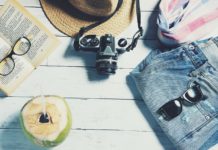Today I want to present a little series by myself that has evolved while I was traveling (and still am) in Southeast Asia. It is no secret that the sun there is very different from what I am used to and it is a lot different than my homeplace Berlin in Germany. The occasions when the sun is out in Germany much rarer and this is also the reason why I love shooting with a flash in the evening when I am at home.
But since I am in Southeast Asia and mainly Indonesia now, I wanted to use the opportunity to create a little series and make the sun an integral part of the shots.
It is not so much about “hardcore” Street Photography where I get up-close to the person. For me, these pictures are more visual and some would even say “cheesy”, but I quite like this change of style for once.
So here is a little overview of what the sun is capable of.

In addition to that, I also want to share some more technical details with You, that become handy if You want to try out a similar style Yourself.
Getting the Exposure right
One of the most challenging parts of these images is to handle the exposure. Digital cameras and sensors are still not the best when it comes to the dynamic range. There are some cameras out there that can handle the contrast and difference between light and darkness better than others, but often times You still are juggling around with the exposure deciding whether You want to accept a blown out sky, or just have a lot of dark space in Your image.

To create the images, You have to learn the manual exposure. There is no way around it, as most cameras will still blow out the highlights. Even when setting the exposure compensation to -3EV, if You are shooting directly into the sun, there is still a great chance that the highlights will be blown out.
The sad thing is, that You can not even recover the blown out highlights. The information that is lost, will be lost forever and no matter how hard You try, Photoshop or Lightroom won’t give You the information back.

That’s where You have to expose manually now and there is a neat little trick that You can use that will give You all the information in the pictures that You need.
Underexpose Your images
The dynamic range and to get the exposure right can be a tricky thing when shooting against the sun. The highlights will blow out very quickly if You expose the picture correctly.
But what does correctly actually mean?

There is no right or wrong when exposing. In fact, for shooting against the sun, it is much more beneficial for me to underexpose the image. I have mentioned that even with an exposure compensation of -3EV a risk persists that the highlights will be blown out. Therefore I sometimes even underexpose more.
Basically, I expose to the highlights which means that I am setting my camera to the manual mode and choose the settings that allow me to get the details of the sun, without it being too bright.
Often times I have to set the aperture f/22 and the shutter speed to 1/2000th of a second and at these settings my camera will already be at its minimum settings.
When looking through the viewfinder, You will notice with these settings that most of the image will be dark and it will appear as if You were shooting just a black mess, but the true magic happens while post-processing now.
Recovering the Shadows

Digital sensors are a bit tricky. While the highlights blow out rather quickly, they are able to recover the shadows with a very wide margin. Although the image does appear very dark at first, there will be still the opportunity to recover the shadows and dark areas.
Even when underexposed for some f-stops, the shadows can be recovered and appear very bright. Though, for most of my images that is not really desirable. I rather have the overall environment visible, while the subjects can remain dark.

In my opinion, this does add some mystic atmosphere to the image and does simply look better in the end. Creating silhouettes in Street Photography is a very common theme and there is a reason for it. They are rather easy to create, yet they are a great way to learn more about the technical details of Your camera. How can You expose manually, how does the focus work and there are many other topics that You can learn while shooting silhouettes.
The right time
One of the crucial aspects of this kind of photography is shooting at the right time. In the morning or in the evening the sun offers the best opportunities to be shot. It stays rather low and the colors are beautiful as well.

Therefore, most of the images have been shot in the evening and I think it is not difficult to find out which pictures have been shot rather during the day. The difference is really noticeable and if You can, You should make use of the morning or the evening.
I hope this series will give You some inspiration and that You will find enough opportunities during the autumn, to use the sun as well.





















